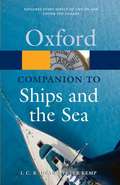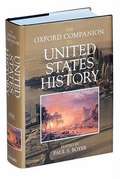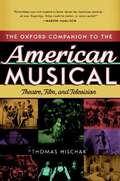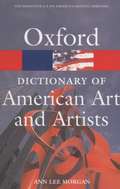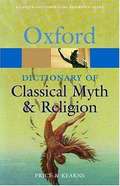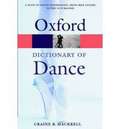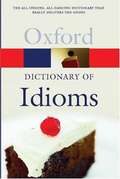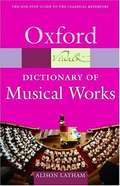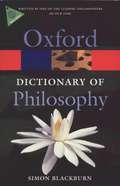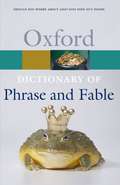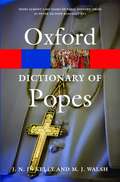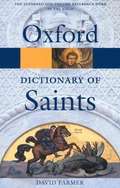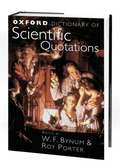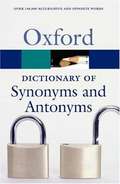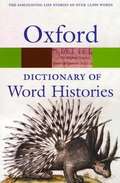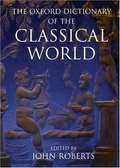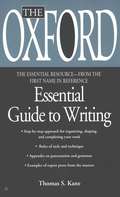- Table View
- List View
The Oxford Companion to Ships and the Sea (2nd edition)
by I. C. B. Dear Peter KempThe most comprehensive and authoritative reference book of its kind, The Oxford Companion to Ships and the Sea is a completely revised and updated edition of a classic volume that was first published in 1976, to huge acclaim. It brings together more than 2,600 entries on every imaginable aspect of the seas and the vessels that sail on them, from shipbuilding, yachting, diving, and marine mammals, to tidal power, piracy, and the literature and language of the sea. The Companion includes authoritative and fascinating entries on maritime history, including its greatest naval battles, like Pearl Harbor and Trafalgar, its most well-known ships, and its most famous individuals, both real and fictional. This second edition provides significant new material on topics that have come to prominence in recent times, such as oceanography and marine archaeology. Key contributions on these subjects include climate change, environmental issues, marine pollution, and marine wildlife. Among the many brand new entries to this edition are up-to-the-minute articles on underwater vehicles, tsunamis, warfare at sea, the Economic Exclusion Zone, and ship preservation. Entries are fully cross-referenced, and the text is now illustrated with over 260 detailed drawings, making it more accessible than ever before. It will prove an essential point of reference for anyone with a professional or amateur interest in the seas, from yachtsmen, maritime historians, and oceanographers, to naval architects, environmentalists, and armchair sailors.
The Oxford Companion to Twentieth-Century Art
by Harold OsborneThe Oxford Companion to Twentieth Century Art provides readers at every level with a wealth of material and information on the art of our time. No other reference book or guide to twentieth-century art covers so wide a range of subjects, or supplies so much detail, as this one-volume assemblage, based on previously scattered information from inaccessible histories, monographs, and widely dispersed exhibition catalogs. Complementing The Oxford Companion to Art, this new Companion treats in far greater depth the artists, ideas, movements and trends of painting, sculpture, and the graphic arts of this century up to the mid 1970s. While it contains mainly entries on individual artists, the contributors also include articles on movements and schools, styles and new technical terms, ranging from Dada and Surrealism to Body Art and Computer Art. It offers separate accounts of art in the United States, Britain, and in the major European countries, as well as articles by leading authorities on the art and artists of Africa, Australia, Canada, Latin America, Mexico, South Africa, and the USSR. The contributors concentrate particularly on the aims and aesthetic theories of individual artists and groups. Including 300 carefully-chosen illustrations--nearly half in color--and a selective bibliography, The Oxford Companion to Twentieth-Century Art will guide students of art and general readers intelligently through the exuberant jungle of contemporary art.
The Oxford Companion to United States History
by Paul S. BoyerA new volume for a new century, The Oxford Companion to United States History covers everything from Jamestown and the Puritans to the Human Genome Project and the Internet. Written in clear, graceful prose for researchers, browsers, and general readers alike, this is the volume that addresses the totality of the American experience, its triumphs and heroes as well as its tragedies and darker moments. Here are the familiar political heroes, from George Washington and Benjamin Franklin to Abraham Lincoln, Woodrow Wilson, and Franklin D. Roosevelt. But here, too, are scientists, writers, radicals, sports figures, and religious leaders, with incisive portraits of such varied individuals as Thomas Edison and Eli Whitney, Babe Ruth and Muhammad Ali, Black Elk and Crazy Horse, Margaret Fuller, Emma Goldman, and Marian Anderson, even Al Capone and Jesse James. The Companion illuminates events that have shaped the nation (the Great Awakening, the Battle of Bunker Hill, the Wounded Knee Tragedy, the Vietnam War); major Supreme Court decisions (Marbury v. Madison, Roe v. Wade); landmark legislation (the Fugitive Slave Law, the Pure Food and Drug Act); social movements (Suffrage, Civil Rights); influential books (The Jungle, Uncle Tom's Cabin); ideologies (conservatism, liberalism, Social Darwinism); even natural disasters and iconic sites (the Chicago Fire, the Johnstown Flood, Niagara Falls, the Lincoln Memorial). Here, too, is the nation's social and cultural history, from Films, Football, and the 4-H Club to Immigration, Courtship and Dating, Marriage and Divorce, and Death and Dying. Extensive multi-part entries cover such key topics as the Civil War, Indian History and Culture, Slavery, and the Federal Government. Here is a volume that is as big and as varied as the nation it portrays. With over 1,400 entries written by some 900 historians and other scholars, it illuminates not only America's political, diplomatic, and military history, but also social, cultural, and intellectual trends; science, technology, and medicine; the arts; and religion.
The Oxford Companion to the American Musical: Theatre, Film, and Television
by Thomas S. HischakFrom the silver screen to the Great White Way, small community theatres to television sets, the musical has long held a special place in America's heart and history. Now, in The Oxford Companion to the American Musical, readers who flocked to the movies to see An American in Paris or Chicago, lined up for tickets to West Side Story or Rent, or crowded around their TVs to watch Cinderella or High School Musical can finally turn to a single book for details about them all. For The first time, this popular subject has an engaging and authoritative book as thrilling as the performances themselves. With more than two thousand entries, this illustrated guide offers a wealth of information on musicals, performers, composers, lyricists, producers, choreographers, and much more. Biographical entries range from early stars Fred Astaire, Bing Crosby, Mary Martin, and Mae West to contemporary show-stoppers Nathan Lane, Savion Glover, and Kristin Chenoweth, while composers Irving Berlin, George Gershwin, Richard Rodgers, and Andrew Lloyd Webber all have articles, and the choreography of Bob Fosse, Tommy Tune, and Debbie Allen receives due examination. The plays and films covered range from modern hits like Mamma Mia! and Moulin Rouge! to timeless classics such as Yankee Doodle Dandy and Show Boat. Also, numerous musicals written specifically for television appear throughout, and many entries follow a work--Babes in Toyland for example--as it moves across genres, from stage, to film, to television. The Companion also includes cross references, a comprehensive listing of recommended recordings and further reading, a useful chronology of all the musicals described in the book, plus a complete index of Tony Award and Academy Award winners. Whether you are curious about Singin' in the Rain or Spamalot, or simply adore The Wizard of Oz or Grease, this well-researched and entertaining resource is the first place to turn for reliable information on virtually every aspect of the American musical. THOMAS HISCHAK is Professor of Theatre at the State University of New York College at Cortland. He is the author of sixteen books on theatre, film, and popular music, including The Oxford Companion to American Theatre; the textbook Theatre as Human Action; and the award-winning American Musical Theatre Song Encyclopedia. He is also the author of twenty published plays.
The Oxford Companion to the Bible
by Michael D. Coogan Bruce M. MetzgerAn authoritative reference for key persons, places, events, concepts, institutions and realities of biblical times, this book also provides discussions on these topics by modern scholars.
The Oxford Companion to the Decorative Arts
by Harold OsborneThe scope of this Companion extends over all the main fields of decorative craftsmanship--as well as a number of minor and specialized ones. It includes prehistoric crafts, crafts like leather-working and ceramics that have arisen more recently, and specialized crafts, such as toys and embroidery. There are also entries on important craftsmen and schools and surveys of specific cultures and periods. All the articles are written by expert contributors and the text is illustrated throughout with photographs and line drawings.
The Oxford Dictionary of American Art and Artists
by Anne Lee MorganHailed by Choice as "concise, clear, and very informative," The Oxford Dictionary of American Art and Artists-- the first such dictionary to appear in three decades-- offers an informative, insightful, and long overdue resource on our nation's artistic heritage. Featuring 945 alphabetically arranged entries, here is an indispensable biographical and critical guide to American art from colonial times to contemporary postmodernism. Readers will find a wealth of factual detail and insightful analysis of the leading American painters, ranging from John Singleton Copley, Thomas Cole, and Mary Cassatt to such modern masters as Jackson Pollack, Romare Bearden, and Andy Warhol. The range of coverage is indeed impressive, but equally important is the quality of analysis that appears in entry after entry. Morgan gives readers a wealth of trustworthy and authoritative information as well as perceptive, well-informed criticism of artists and their work. In addition, the book is thoroughly cross-referenced, so readers can easily find additional information on any topic of interest.
The Oxford Dictionary of Classical Myth and Religion
by Simon Price Emily KearnsDrawn from the acclaimed Oxford Classical Dictionary, The Oxford Dictionary of Classical Myth and Religion offers a fully rounded guide to all aspects of religious life and thought in ancient Greece and Rome. Highly authoritative, this new book covers not only Greek mythologies and Roman festivals, but also devotes attention to topics such as Greek and Roman religious places, monuments, authors and texts, religious organization, imagery, divination, astrology, and magic. Unlike many other references on ancient Greece and Rome, the Dictionary also includes many entries on Judaism and Christianity in the classical world. The editors, area advisors for the third edition of the Oxford Classical Dictionary, have selected, revised, edited, and in some instances completely recast a large number of entries from the OCD to create this handy and accessible reference. The main text is supplemented by an important introductory essay providing overviews of mythology, religious pluralism in the ancient world, and the reception of myths from antiquity to the present. In addition to a helpful thematic index and extensive cross-references, the text is further supported by three maps and six genealogies. Backed by the authority and scholarly rigor of the renowned Oxford Classical Dictionary, The Oxford Dictionary of Classical Myth and Religion is a valuable A-Z reference and is as ideal a tool for students and teachers of ancient history as it is for all classics lovers.
The Oxford Dictionary of Dance
by Debra Craine Judith MackrellThis dance dictionary is most marked by its inclusivity, covering ballet, capoeira, flamenco, hip-hop, jazz, Kabuki, modern, contemporary, raqs sharqi, salsa, tango, tap, and ballroom.
The Oxford Dictionary of Idioms (2nd edition)
by Judith SiefringDid you know that 'flavor of the month' originated in a marketing campaign in American ice-cream parlors in the 1940s, when a particular flavor would be specially promoted for a month at a time? And did you know that 'off the cuff' refers to the rather messy practice of writing impromptu notes on one's shirt cuff before speaking in public? These and many more idioms are explained and put into context in this second edition of the Oxford Dictionary of Idioms. The volume takes a fresh look at the idiomatic phrases and sayings that make English the rich and intriguing language that it is. This major new edition contains entries for over 5000 idioms, including 350 entirely new entries and over 500 new quotations. The text has been updated to include many new idioms using the findings of the Oxford English Reading Program, the biggest language research program in the world. The entries are supported by a wealth of illustrative quotations from a wide range of sources and periods and the text has been entirely redesigned so that it is both elegant and easy to use. Anyone interested in the colorful side of the English language will get hours of fun browsing this fascinating and informative volume.
The Oxford Dictionary of Islam
by John L. EspositoDesigned for general readers with little or no knowledge of Islam, this superb dictionary provides more than 2,000 vividly written, up-to-date, and authoritative entries on the religious, political, and social spheres of the modern Islamic world. Written under the editorship of the prominent scholar of Islam John L. Esposito, The Oxford Dictionary of Islam offers a wealth of information for anyone curious about this burgeoning and increasingly important world religion. Book jacket.
The Oxford Dictionary of Musical Terms
by Alison LathamPrinted music and writing about music involve the use of complex systems of notation and a wealth of technical terms in several languages. The Concise Oxford Dictionary of Musical Terms provides clear, succinct, definitions of a comprehensive range of the musical terms, in English and other European languages, that are likely to be encountered in Western music, including in jazz and popular musical genres. Over 2,500 A-Z entries range across a spectrum of subjects, among them: rhythm, metre, forms, genres, pitch, scales, chords, harmony and counterpoint, notational systems, composition and analysis, performance practice, tempo, expression, musical periods, artistic movements, computer applications, acoustics, and many more. Entries provide etymologies, and are fully cross-referenced. Some are illustrated with music examples and tables. An appendix lists all composers mentioned in the Dictionary, with their dates. It is an ideal book for students and teachers of music - it covers all the terms required in the SMAB musical theory exams - as well as for professional musicians, those learning to play musical instruments, and members of choirs, and musical groups. It will also be a useful quick reference book for concert-goers, CD-collectors, and radio listeners.
The Oxford Dictionary of Musical Works
by Alison LathamAnyone who listens to or plays classical music often wants to put the pieces they encounter in context - to check information ranging from who wrote the piece, or the date of its first performance, to how it acquired its title, or whether it was commissioned for a specific person or occasion.General dictionaries of music only cover a limited number of musical works, and include very little detail. The new Oxford Dictionary of Musical Works provides short articles on over 1750 musical works from earliest times to the present day, providing a comprehensive but handy reference. Entries encompass a broad spectrum of genres - from opera, ballet, choral and vocal music, orchestral, chamber and instrumental pieces, to nicknamed works, collections, national anthems, hymn tunes, and traditional melodies. Each entry outlines the genre to which the piece belongs; the librettist or author of the text, including any literary source; the number of acts or movements; the scoring - including details of the instrumentalists and vocalists needed to perform the piece; how it came to be commissioned; the place and date of its first performance; any subsequent arrangements or revisions; and any additional important or entertaining information.
The Oxford Dictionary of Nicknames
by Andrew DelahuntyThis reference for the general reader contains concise explanations of the origins of over 1,800 nicknames from contemporary and historical culture. They refer to historical figures, politicians, athletes, entertainers, places, events, and organizations and include, for example, "The Gipper" (Ronald Reagan), "The Virgin Queen" (Elizabeth I), "Satchmo" (Louis Armstrong), and "The Garden State" (New Jersey). The volume also features listings of the nicknames of British football clubs and army regiments as well as those for US Army infantry divisions. Annotation ©2004 Book News, Inc., Portland, OR (booknews.com)
The Oxford Dictionary of Philosophy (2nd edition revised)
by Simon BlackburnPhilosophy is human thought become self-conscious. Its topics are life, the universe, and everything; it can include all the categories of religious, artistic, scientific, mathematical, and logical thought. This dictionary of philosophy is a record of some of the terms that excite such reflection, and some that have been found helpful in conducting it.
The Oxford Dictionary of Phrase and Fable (2nd edition)
by Elizabeth KnowlesRevised and enlarged from the 2000 first edition, the dictionary cites words, phrases, and names with cultural resonance, to allow readers to understand and sometimes decode phrases they run across or perhaps have heard for years without ever quite understanding the connotation. The emphasis is on the allusion or reference, though origins of the phrase are also often explained. New here are such terms as nine-eleven (9-11, 9/11), axis of evil, and coalition of the willing. The cross-referencing is extensive. Annotation ©2006 Book News, Inc., Portland, OR (booknews.com)
The Oxford Dictionary of Popes
by J. N. D. KellyThe book is a one-volume handbook in English containing systematic, concise accounts of all those who have been, or claimed to be, popes. It provide summary biographies not only of the officially recognized popes but also of those who have been classified, rightly or wrongly, as anti-popes. The list of pontiffs and, with minor discrepancies, the dating of their reigns are in general agreement with the 1984 edition of Annuario Pontificio.
The Oxford Dictionary of Saints
by David Hugh FarmerThis is far more than a dry hagiographical account of the lives of saints. This entertaining and authoritative dictionary breathes life into its subjects and is as browsable as it is informative. Critically acclaimed in its many editions, the dictionary is now reissued into the rebranded best-selling Oxford Paperback Reference series. The entries are concise accounts of the lives, cults, and artistic associations of over 1,400 saints, from the famous to the obscure, the rich to the poor, and the academic to the uneducated. From all walks of life and from all periods of history, the wide varieties of personalities and achievements of the canonized are reflected. Featuring maps of pilgrimage sights in Europe and fully updated appendices, this remains the standard reference paperback in its field. Recently-added saints include the Martyrs of Korea, Vietnam, and the Spanish Civil War, Andrew of Crete, and Emily Rodat, a female hermit of the 7th century. There are also more Scottish and Irish saints, and ancient Welsh saints; more European saints from all centuries, as well as more saints from Eastern Europe; more recently canonized saints and female saints from the USA.
The Oxford Dictionary of Scientific Quotations
by Roy Porter W. F. BynumThe original words announcing great scientific discoveries, from the first 'Eureka!' to the cloning of Dolly the sheep, can all be found in this fascinating addition to the world-famous Oxford Quotations series. An essential reference tool, put together over fifteen years with the assistance of a distinguished team of specialist advisers, it includes full author descriptions, exact sources, and a word-finding index for easy reference. Scholarly but accessible, it also presents the human face of science, as scientists reflect on achievements and failures in their own lives and those of others. For example, you've probably already hear Darwin's own thoughts on natural selection, but how about his assessment of the pros and cons of marriage? From Archimedes to Einstein and beyond, the Oxford Dictionary of Scientific Quotations charts the progress of the great ideas of science. It is an engaging and surprising read for all lovers of science, history, or wit.
The Oxford Dictionary of Slang
by John AytoA dictionary of common English slang terms and the estimated date of their appearance in the English language.
The Oxford Dictionary of Synonyms and Antonyms
by Oxford University PressAuthoritative, accessible, and completely up to date, this new edition of the popular Oxford Dictionary of Synonyms and Antonyms is an invaluable guide for anyone wanting to build their vocabulary and invigorate their writing skills. Over 140,000 alternative and opposite words are given with the closest, most frequently used synonyms listed first. In addition, thousands of real-life examples of usage from the Oxford English Corpus put the words in the context of sentences, which helps the reader to pinpoint the right word quickly and easily (and avoid embarrassing mistakes). Also included are some useful appendices designed to improve your knowledge of the language: a new Wordfinder section offers a selection of thematic lists--from chemical elements and clothing to phobias and flowers--and a Common Confusables supplement highlights the crucial differences between similar words that are often mixed up. Anyone wanting a practical and accessible language guide that will expand their vocabulary and sharpen their writing skills--including families, word game buffs, and students learning English as a foreign language--will want this dictionary on their reference shelf.
The Oxford Dictionary of Word Histories
by Glynnis ChantrellThe Oxford Dictionary of Word Histories describes the origins and sense development of over 11,000 words in the English language. Well-known idioms such as "say it with flowers" are highlighted with the dates of their original use and how and when they came about. Colorful popular beliefs are explored about the origins of words like "posh" and "snob," and insights are given into our social history revealed by language development such as the connection in a Roman soldier's mind of "salary" with salt. Throughout, boxed word-building elements show the various meanings of shared "relationships" between words.
The Oxford Dictionary of the Classical World (Abridged)
by John RobertsThis abridgment of the 1996 third edition of The Oxford Classical Dictionary, the first in which the Middle East, Jews, and women make a significant appearance, is designed to be accessible, portable, and affordable to students, teachers, and general readers. It focuses on Greek Archaic and Classical periods with some attention to the Hellenist period, and on Rome of the later republic starting with the First Punic War and early empire to the death of Marcus Aurelius. Entries have been selected and simplified, bibliographies removed, technical terms explained, Greek transliterated, and new appendices added on money and ancient-to-modern place names.
The Oxford Essential Guide to Writing
by Thomas S. KaneWhether you’re composing a letter, writing a school thesis, or starting a novel, this resource offers expert advice on how to think more creatively, how to conjure up ideas from scratch, and how to express those ideas clearly and elegantly.
The Oxford Guide to Word Games
by Tony Augarde A. J. AugardeRiddles such as this are just one of the forms of linguistic gymnastics explored in this invaluable source-book. Unique in its thematic and historical approach to the subject, it will tell you everything you ever wanted to know about word games and wordplay, and is entertaining as well as informative. The Oxford Guide to Word Games quickly established itself as the authoritative work on the subject when it was first published in 1984. It not only described all the major word games but also traced their origins and placed them in their social context. Now thoroughly revised, enlarged, and updated to make it even more valuable and comprehensive, this edition includes several new chapters, covering topics such as homonyms and slips of the tongue. New material has also been added on many topics including crossword clues, blends, and kangaroo words. Book jacket.
